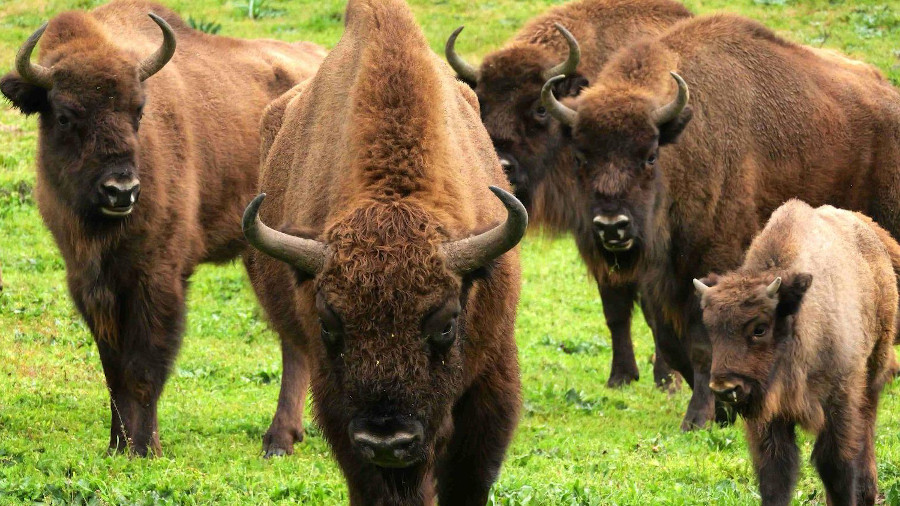European Bison can adapt well to the Mediterranean climate of southern Spain
For the first time, a UAB research team in collaboration with the Spanish National Research Council (CSIC) analyses the feeding habits of European bison herds in Mediterranean forests. The European bison, the largest mammal native to Europe and a protected species in all of the continent, has a unique feeding behaviour and the capacity to adapt to the Mediterranean environment of southern Spain.

A study published by Biodiversity and Conservation which included the involvement of the Universitat Autònoma de Barcelona (UAB) and the Spanish National Research Council (CSIC) for the first time has conducted a comparative analysis of the feeding of three large herbivores, the European bison (Bison bonasus), the red deer (Cervus elaphus) and the fallow deer (Dama dama), all of which coexist in Mediterranean forests. The study was carried out on the El Encinarejo farm, with an area of 1000 ha and located in the Sierra de Andújar (Jaén), characterised by a typical Mediterranean scrubland habitat with a predominance of holm oak groves and an abundance of shrubs such as mastic, lavender and rosemary.
"The European bison is the largest living mammal in Europe, a survivor of a time when large herds of herbivores roamed the grasslands and forests, shaping the landscape and promoting biodiversity”, states Jordi Bartolomé, lecturer at the Universitat Autònoma de Barcelona and first autor of the study.
This bovid was on the verge of extinction at the beginning of the 20th century, and is currently on the IUCN Red List of endangered species, and is therefore a protected species across Europe.
Its wide geographic distribution during the Holocene throughout the European continent, as well as the success of populations introduced in the past decades into different European regions, have revealed the capacity and plasticity of the species to adapt to new habitats and a broad bioclimatic range.
"The creation of new breeding nuclei in semi-free conditions has become a strategy to guarantee the survival of the species, which in turn allows the application of its potential to restore and improve the biodiversity of these areas", says Jorge Cassinello, CSIC researcher at the Experimental Station of Arid Areas (EEZA) and co-author of the study.
At the end of 2020, 18 specimens were introduced into the El Encinarejo farm, located in the Sierra de Andújar (Jaén) and representing the southernmost range limit of this species to date. At the farm, the bison coexist with other herbivorous ungulates, some 400 red deer and 200 fallow deer. To discover how each species used these trophic resources, faecal samples were collected seasonally in the year 2021. The microhistological analysis technique was used to determine the percentage of epidermal fragments of the main functional food groups (woody plants, grasses, legumes, and forbs) found in each sample.
The results show significant differences between animal species and seasons of the year. Thus, woody plants are preferentially consumed in autumn and winter, grasses in summer, and leguminous and herbaceous plants in spring. The woody component was the most abundant in the diet of the three species, representing 81% of the plant fragments present in deer faeces, 52% in bison and 38% in fallow deer.
"This is the first study that evidences the consumption of mastic (Pistacia lentiscus) by European bison, and the abundant presence in their diet in all seasons indicates that it is a very important food source," says Bartolomé.
The comparison of feeding behaviour among the three herbivore species showed that bison consumed significantly more grasses (21%), while legumes were more present in the diet of fallow deer (32%). The red deer, on the other hand, consumed less grasses than the other two species (8%).
"The main conclusion we can draw from this work is the existence of a distribution of trophic resources among the three species of herbivores when they coexist in the same habitat, which seems to demonstrate their ability to coexist together, and, moreover, the ability of the bison to adapt to the bioclimatic conditions of Mediterranean environments," concludes Cassinello.
The authors of the work finally point out that, "beyond the fact that the European bison did or did not inhabit the Iberian Peninsula in the past (a fact yet to be determined palaeontologically), and as proposed by other researchers, the time has come to implement effective conservation measures that allow the increase and maintenance of biodiversity, and to focus primarily on the ecosystemic functions of the species rather than on their origin".
Original article:
Bartolomé Filella, J., Morán, F., Kemp, Y.J.M., Munir, H., Gort-Esteve, A. y Cassinello, J. Diet comparison between sympatric European bison, red deer and fallow deer in a Mediterranean landscape. Biodivers Conserv (2024). https://doi.org/10.1007/s10531-024-02832-x
The UAB, with Sustainable Development Goals
Life on land
Partnerships for the goals